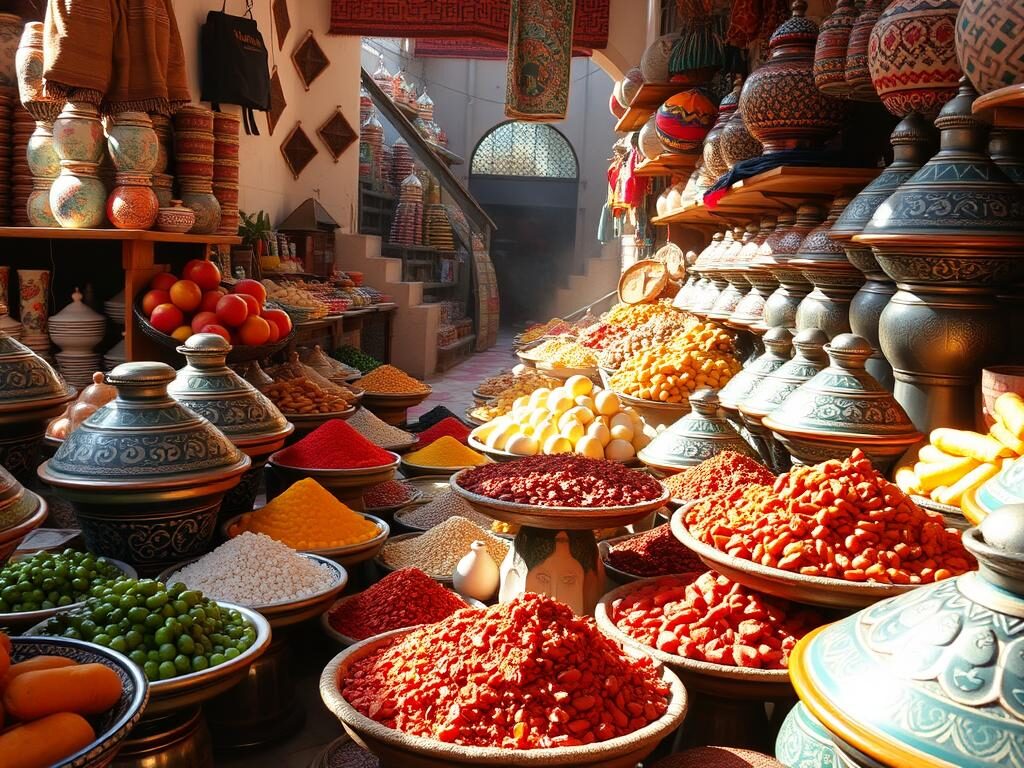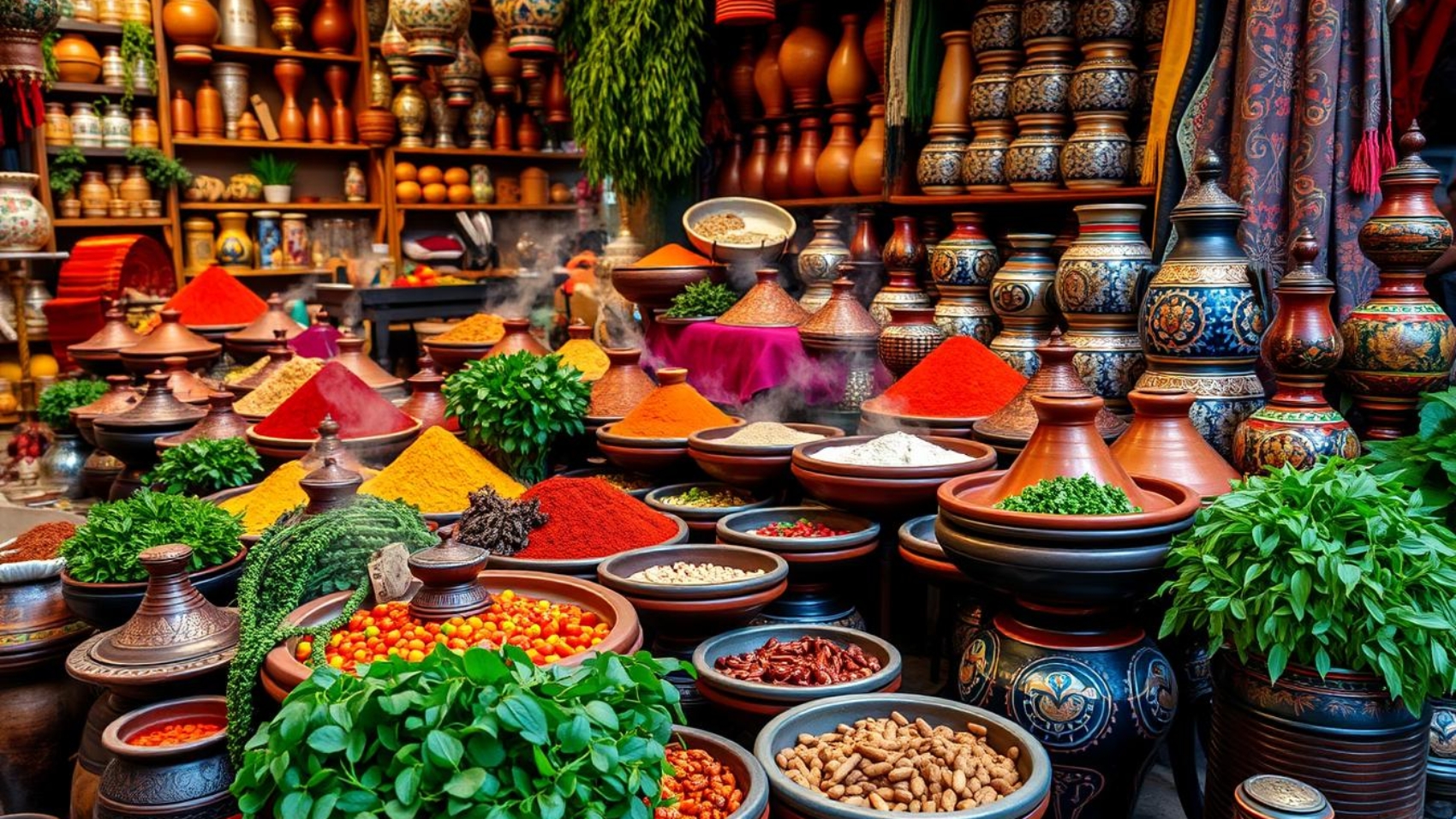Welcome to the vibrant world of Moroccan cuisine. Here, rich flavors and diverse dishes make for a unique culinary journey. Food in Morocco is more than just food; it’s a way to connect families and communities.
Traditional Moroccan cuisine combines Berber, Arab, and Mediterranean influences. This mix creates a wide range of dishes that show the nation’s history and heritage.
Exploring Moroccan cuisine, you’ll see that meals are more than just food. They hold deep cultural significance. Let’s dive into what makes this cuisine special and celebrate the joy of sharing a meal.
Introduction to Moroccan Cuisine
Moroccan cuisine is a mix of many cultures, shaped by history and geography. Morocco’s mountains, deserts, and coasts add to its flavors. This variety leads to a wide range of dishes, all rich in spices, fresh ingredients, and aromas.
Spices are key in Moroccan food, adding depth to each dish. Spices like cumin, coriander, saffron, and cinnamon are used a lot. They make every meal special. In Morocco, eating together is important, bringing families and friends closer.
Traditional Moroccan recipes tell stories of the past. Dishes like tagine and couscous are famous worldwide. They show the beauty of Moroccan food and its rich history and culture.
Exploring Traditional Moroccan Dishes
Moroccan dishes show the rich flavors and traditions of authentic Moroccan cuisine. Each dish has its own story, blending different ingredients and cooking methods.
The tagine is a key part of Moroccan food. It’s a slow-cooked stew made in a special pot. It combines meat or fish with veggies and spices, creating a dish full of flavor. The long cooking time makes the flavors mix perfectly, offering a hearty meal.
Couscous is another important dish, often eaten with tagine. It’s a light, fluffy grain made from semolina. It’s steamed to perfection, making it a great base for various sauces and toppings. Couscous is loved for its versatility in Moroccan cuisine.
Pastilla is also a must-try. It’s a mix of sweet and savory, with layers of pastry filled with pigeon or chicken, almonds, and spices. It’s topped with powdered sugar and cinnamon. Pastilla shows the unique balance of flavors in Moroccan dishes.
Harira is a hearty soup enjoyed during Ramadan. It’s made with tomatoes, lentils, chickpeas, and spices. It’s served with bread for dipping, showing the importance of family and community in Moroccan dining.
Traditional Moroccan dishes are known for their unique tastes. They show the deep influence of local ingredients and traditions. Whether it’s a big feast or a simple meal, Moroccan cuisine always delights the senses.
Understanding Moroccan Food Culture
Moroccan food culture is a rich mix of traditions that go back centuries. Meals in Morocco are more than just food; they are about family and culture. Families come together, sharing a big plate, which brings them closer.
Hospitality is key in Morocco. Serving food to guests shows respect and kindness. Guests are welcomed with traditional dishes, showing the value of sharing and connection.
Food is especially important during holidays and special events. Dishes are chosen to honor these times. Whether it’s Ramadan, weddings, or family get-togethers, food brings everyone together. Sharing meals highlights the strong bonds within families and communities.
Food in Morocco: A Gastronomic Adventure
Moroccan cuisine is a mix of flavors, shaped by the country’s geography and culture. Each region in Morocco has its own dishes, using local ingredients and traditions. From the coast’s seafood to the mountains’ hearty dishes, every area has its own taste.
Regional Variations in Moroccan Dishes
In Essaouira, fresh seafood is a big deal, with grilled fish and special spices. The Atlas Mountains are known for Berber dishes like tagines and couscous, with fresh veggies and herbs. The Sahara region brings bold flavors, with camel meat and local herbs.
This variety makes Moroccan food exciting and different every time you try it.
Festivals and Celebrations Featuring Moroccan Food
Moroccan food festivals are great for trying different dishes and celebrating traditions. The Fes Festival of World Sacred Music is a chance to enjoy many dishes, showing how food and culture are connected. The Chefchaouen Street Food Festival is another highlight, with street foods that show off local tastes.
These events help share Moroccan food with the world. They also bring people together and encourage cultural exchange.

The Role of Spices in Moroccan Cooking
Moroccan cuisine is known for its bold flavors, thanks to its unique spices. These spices make every dish special. Learning about Moroccan spices lets you enjoy authentic Moroccan food at home.
Commonly Used Spices in Moroccan Recipes
Cumin, coriander, saffron, and cinnamon are key spices in Moroccan cooking. Each spice adds its own flavor, blending together to create a rich taste:
- Cumin: Adds warmth and earthiness, often featured in tagines and stews.
- Coriander: Offers a bright, citrusy flavor that complements meat dishes beautifully.
- Saffron: A luxurious spice that imparts a glorious golden hue and a nuanced taste, elevating rice and couscous dishes.
- Cinnamon: Brings sweetness and warmth, frequently used in both savory and sweet Moroccan dishes.
How to Use Moroccan Spices at Home
Adding Moroccan spices to your cooking can be fun and rewarding. Here are some tips to help you succeed:
- Start with whole spices for a fresher flavor. Toasting them lightly in a dry pan releases their essential oils.
- Experiment with blending spices to create personalized spice mixtures for various dishes.
- Store spices in a cool, dark place in airtight containers to maintain their potency.
- Use spices generously but balance them according to taste preferences to truly capture authentic Moroccan cuisine.
Famous Moroccan Foods You Must Try
Morocco’s food scene is full of flavors, making it a treat for anyone who tries it. Some dishes are especially popular, showing off the country’s rich culture and traditions.
- Merguez Sausage – This spicy lamb sausage is loved everywhere. It’s often grilled or used in tagines, with flavors of cumin and harissa.
- Zaalouk – A tasty eggplant and tomato salad, zaalouk is great as a spread or side. The smoky eggplant adds a unique taste.
- Moroccan Mint Tea – This green tea with mint and sugar is Morocco’s favorite drink. It’s served in fancy glasses, symbolizing hospitality and friendship.
Tasting these dishes is more than just food; it’s a way to dive into Moroccan culture. Meals here are filled with stories and traditions. Trying these famous foods makes any trip to Morocco unforgettable.
Iconic Moroccan Recipes to Make at Home
Exploring traditional Moroccan cuisine at home is a thrilling adventure. It’s filled with rich flavors and colorful ingredients. Here are some favorite Moroccan recipes to try in your kitchen.
- 4 chicken thighs, skinless
- 2 preserved lemons, quartered
- 1 large onion, sliced
- 2 cloves of garlic, minced
- 1 teaspoon ground ginger
- 1 teaspoon paprika
- Fresh parsley for garnish
First, brown the chicken in a tagine or deep pan. Add onions and garlic, letting them soften. Then, mix in spices and preserved lemons. Cover and simmer for 45 minutes, until the chicken is tender. Serve with couscous for a true Moroccan experience.
Lamb Couscous is another must-try. It’s hearty and highlights Moroccan cuisine’s essence. You’ll need:
- 1 lb lamb, cubed
- 2 cups couscous
- 4 cups broth (chicken or vegetable)
- 1 carrot, diced
- 1 zucchini, diced
- Spices: cumin, coriander, and cinnamon
Brown the lamb in a pot. Add diced veggies and broth, simmering until the lamb is tender. Cook the couscous as directed. Mix everything together and serve warm.
Try Traditional Moroccan Salads like *Salad Beldi* for a burst of freshness. Just chop tomatoes and green peppers, drizzle with olive oil, and season with salt and cumin. It’s a light side dish that captures Moroccan flavors.
Using authentic ingredients can make your dishes even better. Local markets often have Moroccan spices and preserved lemons. This ensures your meals are true to Moroccan cuisine.
Feel free to modify these recipes to suit your taste. Moroccan cuisine is all about exploring vibrant flavors and textures. As you cook Moroccan dishes, you’ll bring a taste of Morocco right to your home.
Dining Etiquette in Morocco
Learning about Moroccan dining etiquette makes meals more special. It shows respect for cultural traditions. A big rule is to eat with your right hand. This is because the right hand is seen as cleaner and more respectful.
Meals are shared, showing the importance of community in Moroccan culture. Guests often take food from a big platter. This way, everyone is together, enjoying the meal.
Bread is a big part of Moroccan meals. It’s used as a utensil and connects diners to their heritage. It’s a key part of every meal.
Serving tea is a big tradition in Morocco. The tea, made with mint, is poured high to make a frothy top. This act shows hospitality and generosity. It makes the dining experience even more special.
By following these dining rules, you’ll enjoy your meals more. You’ll also learn a lot about Moroccan culture. It makes every meal a special way to experience Moroccan identity.
Conclusion
Exploring Moroccan cuisine is like diving into a world of flavors and traditions. It’s not just about eating tasty food. It’s about connecting with the culture and history behind each dish.
Try cooking Moroccan dishes at home to truly experience its flavors. You can find recipes online that use special spices and ingredients. This way, you can share Moroccan culture with your loved ones.
The flavors of Moroccan cuisine are meant to be shared. Encourage others to try Moroccan food and learn about its traditions. This will make your culinary journey even more special.
FAQ
What are the most popular traditional Moroccan dishes?
In Morocco, you’ll find favorites like tagine, couscous, pastilla, and harira. These dishes highlight the country’s rich flavors. They use unique ingredients and cooking methods.
How does Moroccan food culture differ from other cuisines?
Moroccan food culture values sharing meals with family and friends. It’s about building strong bonds. Serving food to guests shows respect and warmth, making dining a key part of Moroccan life.
Can you describe the role of spices in Moroccan cooking?
Spices are key in Moroccan cooking, adding deep flavors to dishes. Spices like cumin, coriander, saffron, and cinnamon are common. They not only taste great but also give Moroccan food its unique aroma.
What regional variations exist in Moroccan food?
Moroccan food varies by region. Coastal areas like Essaouira are known for seafood. The Atlas Mountains have Berber-inspired dishes. Each area has its own specialties, showing local ingredients and traditions.
Are there any food festivals that celebrate Moroccan cuisine?
Yes, Morocco hosts food festivals like the Fes Festival of World Sacred Music and the Chefchaouen Street Food Festival. These events celebrate Moroccan cuisine and bring people together through food.
What are some famous Moroccan foods to try when visiting Morocco?
You must try merguez sausage, zaalouk, and Moroccan mint tea when in Morocco. These dishes offer a taste of the country’s diverse flavors and cooking techniques.
How can I make authentic Moroccan recipes at home?
To make authentic Moroccan dishes, try recipes like chicken tagine with preserved lemons and lamb couscous. Use authentic ingredients and traditional methods for the best results.
What is the etiquette for dining in Morocco?
In Morocco, eat with your right hand and share meals from a platter. Use bread to scoop food. Tea is also a big part of dining, often served with ceremony to guests.


